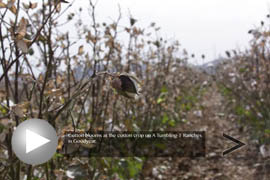Arizona’s Five Cs: Cotton

Cotton continues to pad farmers’ pockets
Upland cotton bolls bloom on the Tumbling-T Ranches in Goodyear. Photo by Joseph SchmidtBy Joseph Schmidt
GOODYEAR – Arizona’s fertile, flat desert land, warm climate and abundant water made for great agricultural conditions.
Though many crops could thrive in this environment, farmers in the early 1900s chose to grow cotton because it sold at high prices, produced large yields and was relatively easy to grow.
In 1913, a year after statehood, Ronald Rayner’s grandfather arrived in Arizona and began farming. Though he started with potatoes and onions, cotton was often used as a rotational crop.
Nearly a century later, Rayner and his brothers Robert and Earle continue that legacy on their own farms, A Tumbling-T Ranch in Goodyear, where they also grow alfalfa, durum wheat and other crops.
“We farm total about 5,000 acres,” Rayner said. “This year we had about 1,500 acres devoted to cotton.”
Arizona’s softest ‘C’ has a profitable history in the state.
“In the past, cotton has been called king in Arizona,” said Rick Gibson, Pinal County agricultural agent with the University of Arizona Cooperative Extension. “Usually farmers can make pretty good money.”
And though the crop’s prices may fall from time to time, Gibson said that it always comes back up.
“Other crops tend not to pay off as well as cotton or are not as easily grown,” Gibson said. “And right now, cotton prices are fairly high … We’ve seen large acreages planted to cotton in 2011.”
The National Agricultural Statistics Service reports that 259,000 acres of cotton were harvested in the last year, the largest amount in 10 years.
Cotton may now be seeing a rebound from Arizona’s recent growth spurt, when development was rampant..
“In the recent past, there has been huge pressure for urban growth,” Gibson said. “Most developers put houses and other infrastructure on flat-level ground with utilities, power and water in close vicinity.”
But Rayner said the last three years have been good for his business, accounting for the highest crop prices he’s seen in 50 years of farming.
“We’ve never seen these levels of crop pricing,” Rayner said. “It’s been the thing we’ve dreamed about all our life, where we can actually make a profit.”
Though the acreage of cotton still hasn’t reached that of its glory days in the ’40s and ’50s, when cotton crops averaged around 400,000 acres a year, Gibson said he believes the industry is on the rise.
“We’re seeing a pendulum swinging back and forth,” Gibson said. “I think we’re seeing a resurgence of cotton.”









